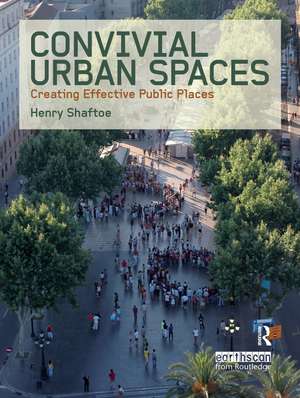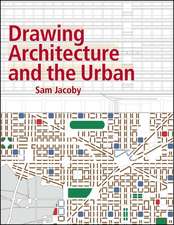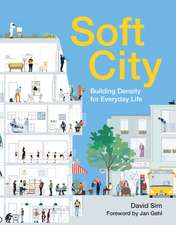Convivial Urban Spaces: Creating Effective Public Places
Autor Henry Shaftoeen Limba Engleză Hardback – 4 iun 2008
Convivial Urban Spaces demonstrates that successful urban public spaces are an essential part of a sustainable built environment. Without them we are likely to drift into an increasingly private and polarized society, with all the problems that would imply. Taking a multidisciplinary approach, this book draws on research, and the literature and theory of environmental psychology and urban design, to advance our understanding of what makes effective public spaces. Practical guidance is illustrated with case studies from the UK, Spain, Germany and Italy. The result is a practical and clearly presented guide to urban public space for planners, architects and students of the urban environment.
Preț: 766.24 lei
Preț vechi: 1028.60 lei
-26% Nou
Puncte Express: 1149
Preț estimativ în valută:
146.62€ • 153.47$ • 122.03£
146.62€ • 153.47$ • 122.03£
Carte tipărită la comandă
Livrare economică 31 martie-14 aprilie
Preluare comenzi: 021 569.72.76
Specificații
ISBN-13: 9781844073887
ISBN-10: 1844073882
Pagini: 160
Dimensiuni: 189 x 246 x 15 mm
Greutate: 0.57 kg
Ediția:1
Editura: Taylor & Francis
Colecția Routledge
Locul publicării:Oxford, United Kingdom
ISBN-10: 1844073882
Pagini: 160
Dimensiuni: 189 x 246 x 15 mm
Greutate: 0.57 kg
Ediția:1
Editura: Taylor & Francis
Colecția Routledge
Locul publicării:Oxford, United Kingdom
Public țintă
Professional Practice & DevelopmentCuprins
Introduction 1. Public Spaces - Why Have Them and Who Are They For? 2. What Makes a Space Convivial? 3. How Can One Create and Sustain Successful Public Spaces? 4. Conclusion:The Constituents of Conviviality References and Bibliography Index
Notă biografică
Henry Shaftoe is a senior lecturer, specializing in safer, better neighbourhoods, at the University of the West of England. He has also worked as a consultant with the Safe Neighbourhoods Unit (a national not-for-profit organization) and undertakes research into many aspects of urban safety and quality of life.
Recenzii
'Brilliant! This thoughtful and illuminating book fills a significant gap in urban design literature and is a must-have reference book for anyone concerned with the creation or management of the public realm.'Michele Lavelle, Partner in 4D Landscape Design 'This is a book full of do's and dont's; a manual to help landscape architects and urban planners improve public space; a book that inspires philosophers to consider and develop Shaftoe's message; and a book rich in good practices noted by a traveller and teacher with the hawk-eye of an architect and photographer. 'Tobias Woldendorp, Senior CPTED Consultant at DSP-groep, Amsterdam.'Henry Shaftoe's comprehensive and accessible book covers both the sociological and psychological aspects of the human occupation of urban space, as well as its physical design aspects, and is a welcome addition to the literature of urban design placemaking.'Joe Holyoak, Course Director, MA Urban Design, Birmingham City University'Offer(s) unique contributions to the public life conversation, delivering practical, well explored and documented observations about public life and the arenas that support them.'Building Research & Information'Practical, clearly represented and inspiring'Proceedings of the Institution of Civil Engineers'Enjoyable and comprehensive, and it offers valuable, applicable suggestions on how to understand public space and how to design vibrant and convivial public spaces.'re:place Magazine'should become standard references for creative urban designers, Shaftoe...admirably direct and always constructive.'Urban Design International Journal 15 (2010)
Descriere
Convivial Urban Spaces demonstrates that successful urban public spaces are an essential part of a sustainable built environment. Without them we are likely to drift into an increasingly private and polarized society, with all the problems that would imply. Taking a multidisciplinary approach, this book draws on research, and the literature and theory of environmental psychology and urban design, to advance our understanding of what makes effective public spaces. Practical guidance is illustrated with case studies from the UK, Spain, Germany and Italy. The result is a practical and clearly presented guide to urban public space for planners, architects and students of the urban environment.












